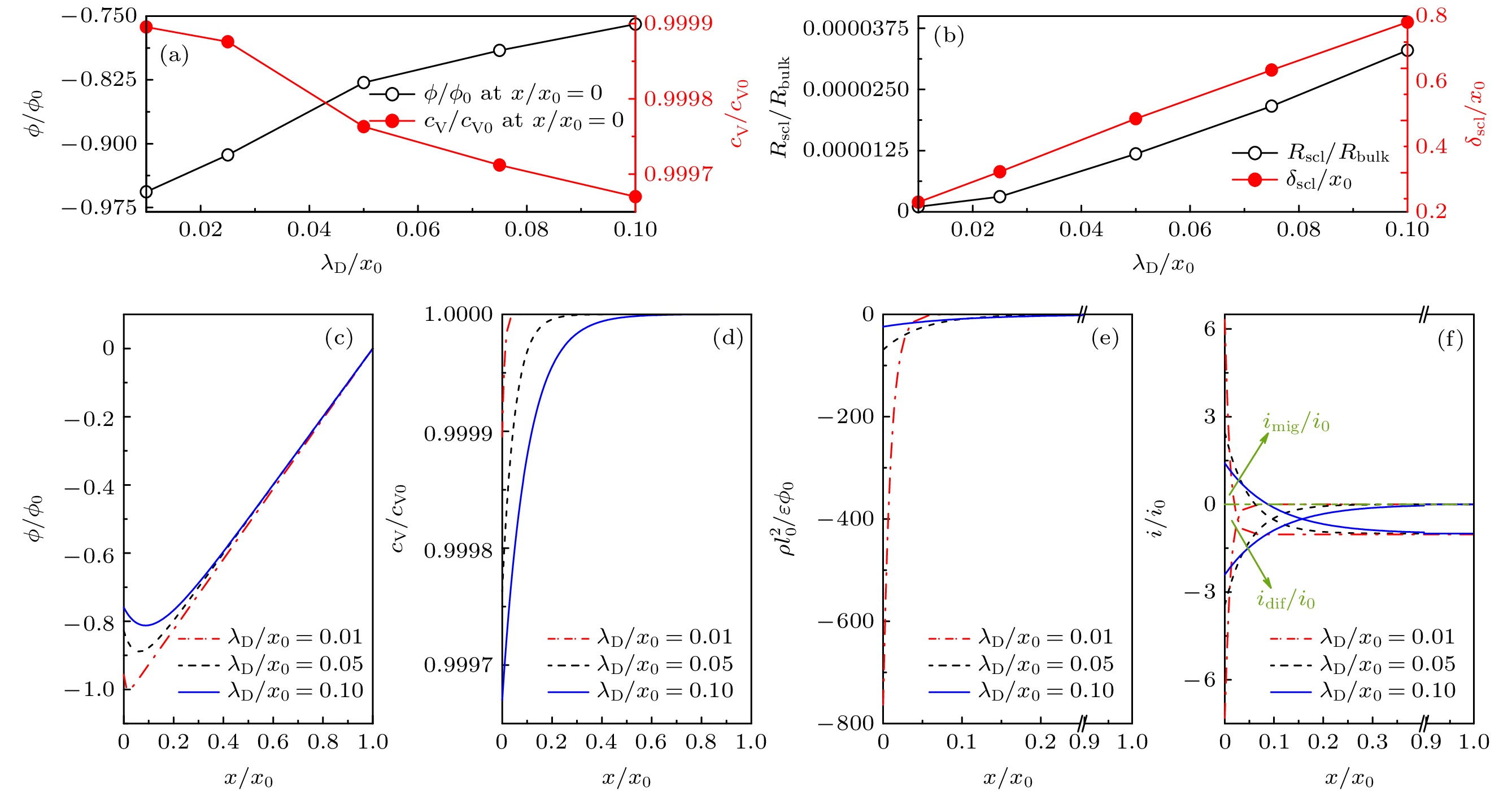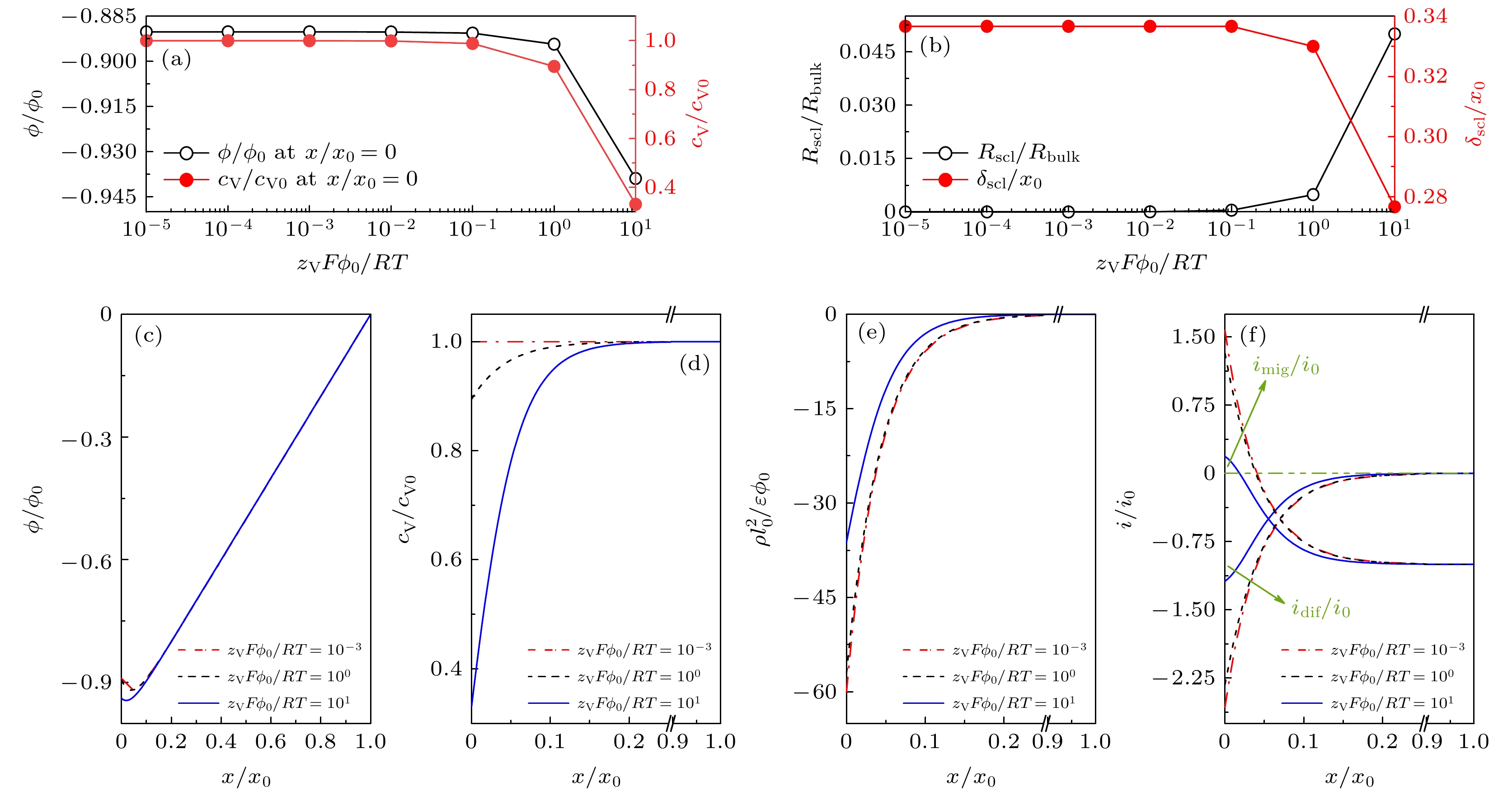-
晶界或异质界面诱发的空间电荷层(space charge layer, SCL)效应, 被认为是氧离子导体电解质内界面附近区域载流子传输特性显著区别于体相区域的关键原因之一. 现有研究多采用Poisson-Boltzmann (PB)方程预测SCL效应的影响规律, 但其基于载流子电化学平衡假设, 无法用于载流子存在宏观运动的工况, 极大限制了相关传输机理研究. 本文耦合Poisson方程和载流子质量守恒方程, 建立了适用于载流子具有宏观运动时氧离子导体内载流子传输过程的模型, 推导了控制SCL效应的关键无量纲参数. 聚焦固体氧化物燃料电池中常用的AO2-M2O3氧离子导体电解质, 对比研究了传统PB方程和本文建立的Poisson-载流子质量守恒耦合方程的预测结果可靠性. 进一步采用耦合模型深入分析了考虑SCL效应时氧离子导体内部氧空位传输机理, 发现导体界面电流密度增大导致SCL电阻先减小后增大. 增大无量纲Debye长度(表征空间电荷层厚度与导体厚度的比值)可显著增大SCL电阻. 当驱动氧空位移动的过电势与热势数量级相当时, 增大无量纲电势(表征过电势与热势的比值)导致SCL电阻增大; 当过电势远小于热势时, 改变无量纲电势对氧空位传输过程几乎无影响. 本文研究结论可为通过合理设计晶界或异质界面以改善氧离子导体内载流子传输能力及最终提高相关电化学器件性能提供理论依据.Space charge layer (SCL) effect induced by interfaces, e.g., grain boundaries in the polycrystals or heterointerfaces in the composites, may make the characteristics of the charge carrier transport near the interfaces significantly different from those in the bulk area. In previous studies, the Poisson-Boltzmann (PB) equation was widely used to model the SCL effect, in which all the charge carriers were assumed to be in electrochemical equilibrium. However, the assumption of the electrochemical equilibrium is no longer valid when the charge carriers exhibit macroscopic motion. In this paper, we develop a model to simulate the charge carrier transport within the oxygen-ion conductor, particularly in the SCL, in which the charge carrier mass conservation equation is coupled to the Poisson equation. Our present coupled model, in which the assumption of the electrochemical equilibrium is not employed, is therefore able to simulate charge carrier transport with macroscopic motion. Two key dimensionless parameters governing the SCL effect are deduced, i.e. the dimensionless Debye length characterizing the ratio of Debye length to the thickness of oxygen-ion conductor, and the dimensionless potential representing the relative importance of the overpotential to the thermal potential. Taking AO2-M2O3 oxide for example, the conventional model with using PB equation and our present coupled model are compared for predicting the SCL effect. Furthermore, the mechanism of the oxygen vacancy transport in the oxygen-ion conductor with considering the SCL effect is thoroughly discussed. In a brief summary, with increasing the current density at the interface, the SCL resistance shows a non-monotonical tendency, i.e., it firstly decreases and then increases. Besides, enlarging the dimensionless Debye length significantly increases the SCL resistance. The influence of increasing the dimensionless potential on the oxygen vacancy transport is obvious when the overpotential is comparable to the thermal potential, but it becomes negligible when the overpotential is far less than the thermal potential. These results may offer helpful guidance for enhancing the performance of oxygen-ion conductors by rationally designing the grain boundaries and heterointerfaces.
-
Keywords:
- oxygen-ion conductor /
- space charge layer /
- oxygen vacancy transport /
- potential
[1] Goodenough J B 1992 Mater. Sci. Eng. B 12 357
 Google Scholar
Google Scholar
[2] 陈跃云, 侯春菊, 孔祥山, 刘长松, 王先平, 方前锋 2011 60 046603
 Google Scholar
Google Scholar
Chen Y Y, Hou C J, Kong X S, Liu C S, Wang X P, Fang Q F 2011 Acta Phys. Sin. 60 046603
 Google Scholar
Google Scholar
[3] Maier J 1995 Prog. Solid State Chem. 23 171
 Google Scholar
Google Scholar
[4] Guo X, Mi S B, Waser R 2005 Electrochem. Solid-State Lett. 8 J1
 Google Scholar
Google Scholar
[5] Michael S, Eklund P, Pryds N, Johnson E, Helmersson U, Bottiger J 2010 Adv. Funct. Mater. 20 2071
 Google Scholar
Google Scholar
[6] Fan L D, Zhu B, Su P C, He C X 2018 Nano Energy 45 148
 Google Scholar
Google Scholar
[7] Zhao C H, Li Y F, Zhang W Q, Zheng Y, Lou X M, Yu B, Chen J, Chen Y, Liu M L, Wang J C 2020 Energy Environ. Sci. 13 53
 Google Scholar
Google Scholar
[8] Beekmans N M, Heyne L 1976 Electrochim. Acta 21 303
 Google Scholar
Google Scholar
[9] Guo X, Sigle W, Maier J 2003 J. Am. Ceram. Soc. 86 77
 Google Scholar
Google Scholar
[10] Mebane D S, De Souza R A 2015 Energy Environ. Sci. 8 2935
 Google Scholar
Google Scholar
[11] Ohtomo A, Hwang H Y 2004 Nature 427 423
 Google Scholar
Google Scholar
[12] Dagotto E 2007 Science 318 1076
 Google Scholar
Google Scholar
[13] Connor P A, Yue X L, Savaniu C D, Price R, Triantafyllou G, Cassidy M, Kerherve G, Payne D, Maher R C, Cohen L F, Tomov R I, Glowacki B A, Kumar R V, Irvine John T S 2018 Adv. Energy Mater. 8 1800120
 Google Scholar
Google Scholar
[14] 高韶华, 王玉霞, 王宏伟, 袁帅 2011 60 086601
 Google Scholar
Google Scholar
Gao S H, Wang Y X, Wang H W, Yuan S 2011 Acta Phys. Sin. 60 086601
 Google Scholar
Google Scholar
[15] Gregori G, Merkle R, Maier J 2017 Prog. Mater Sci. 89 252
 Google Scholar
Google Scholar
[16] Parras J P, De Souza R A 2020 Acta Mater. 195 383
 Google Scholar
Google Scholar
[17] Kharton V V 2011 Solid State Electrochemistry II: Electrodes, Interfaces and Ceramic Membranes (Weinheim: Wiley-VCH Verlag & Co. KGaA) p33
[18] Tong X, Mebane D S, De Souza R A 2020 J. Am. Ceram. Soc. 103 5
 Google Scholar
Google Scholar
[19] Newman J, Thomas-Alyea K E 2004 Electrochemical Systems (3rd Ed.) (New Jersey: John Wiley & Sons, Inc.) p186
[20] Nelson G J, Cassenti B N, Peracchio A A, Chiu Wilson K S 2012 J. Power Sources 205 48
 Google Scholar
Google Scholar
[21] 徐晗, 张璐, 党政 2020 69 098801
 Google Scholar
Google Scholar
Xu H, Zhang L, Dang Z 2020 Acta Phys. Sin. 69 098801
 Google Scholar
Google Scholar
[22] Xu H, Chen Y, Kim J H, Dang Z, Liu M L 2019 Int. J. Hydrogen Energy 44 30293
 Google Scholar
Google Scholar
[23] Zhang L, Wang M R 2017 J. Colloid Interface Sci. 486 219
 Google Scholar
Google Scholar
[24] Kamali R, Soloklou M N, Hadidi H 2018 Chem. Phys. 507 1
 Google Scholar
Google Scholar
[25] 何雅玲, 王勇, 李庆 2009 格子Boltzmann方法的理论及应用 (北京: 科学出版社) 第214, 215页
He Y L, Wang Y, Li Q 2009 Lattice Boltzmann Method: Theory and Applications (Beijing: Science Press) pp214, 215 (in Chinese)
-
图 2 Poisson-载流子质量守恒耦合方程(Present model)与PB方程(PB equation)的计算结果比较 (a)导体净电流密度为0时, 本文发展的PB方程LB模型与耦合方程LB模型的计算结果与文献[18]求解PB方程获得的计算结果比较, 其中α = F/(RT), lMS = [ϕ(0)ε0εr/(FcV0)]0.5; (b), (c)导体净电流密度不为0时的计算结果
Fig. 2. Comparison of the results predicted by the coupled Poisson and charge carrier mass conservation equation (Present model) and the PB equation. (a) The net current density is 0. Results predicted by the PB equation from Ref. [18] is also presented for the comparison purpose. Here, α = F/(RT) and lMS = [ϕ(0)ε0εr/(FcV0)]0.5. (b), (c) Results of the case that the net current density is not 0
图 3 无量纲界面电流密度(iB/i0)对(a)界面处电势与氧空位浓度及(b)空间电荷层电阻与厚度的影响; 当iB/i0 = 2, 4, 6时, (c)导体内电势、(d)氧空位浓度、(e)电荷密度及(f)电流密度分布
Fig. 3. Effects of dimensionless current density at the interface (iB/i0) on (a) the potential and oxygen vacancy concentration at the interface, and (b) the resistance and thickness of SCL. Distributions of (c) potential, (d) oxygen vacancy concentration, (e) charge density and (f) current density within the conductor when iB/i0 = 2, 4 and 6, respectively.
图 4 无量纲Debye长度(λD/x0)对(a)界面处电势和氧空位浓度及(b)空间电荷层电阻与厚度的影响; 当λD/x0 = 0.01, 0.05, 0.1时, (c)导体内电势、(d)氧空位浓度、(e)电荷密度及(f)电流密度分布
Fig. 4. Effects of dimensionless Debye length (λD/x0) on the (a) potential and oxygen vacancy concentration at the interface, and (b) the resistance and thickness of SCL. Distributions of (c) potential, (d) oxygen vacancy concentration, (e) charge density and (f) current density within the conductor when λD/x0 = 0.01, 0.05 and 0.1, respectively.
图 5 无量纲电势(zVFϕ0/(RT))对(a)界面处电势和氧空位浓度及(b)空间电荷层电阻和厚度的影响; 当zVFϕ0/(RT) = 10–3, 1与10时, (c)导体内电势、(d)氧空位浓度、(e)电荷密度及(f)电流密度分布
Fig. 5. Effects of dimensionless potential (zVFϕ0/(RT)) on (a) the potential and oxygen vacancy concentration at the interface, and (b) the resistance and thickness of SCL. Distributions of (c) potential, (d) oxygen vacancy concentration, (e) charge density and (f) current density within the conductor when zVFϕ0/(RT) = 10–3, 1 and 10, respectively.
表 1 演化方程(20)还原不同控制方程时所涉及的平衡分布函数、源项和求解变量表达式
Table 1. Equilibrium distribution function, source term and variable expression in the evolution Eq. (20) for obtaining different governing equations.
无量纲PB方程((12)式) 无量纲Poisson方程((13)式) 无量纲载流子质量守恒方程((14)式) 平衡分布函数(fαeq) ${w_\alpha }{\phi ^*}$ ${w_\alpha }{\phi ^*}$ ${w_\alpha }c_{\rm{V}}^{*}$ 源项(Rg) $- \dfrac{ { {D^*} } }{ { { {\left( {\lambda _{\rm{D} }^*} \right)}^2}{Q^*} } }\left[ {1 - \exp \left( { - {Q^*}{\phi ^*} } \right)} \right]$ $- \dfrac{ { {D^*} } }{ { { {\left( {\lambda _{\rm{D} }^*} \right)}^2}{Q^*} } }\left( {1 - c_{\rm{V} }^{*} } \right)$ ${D^{*}}{Q^{*}}\nabla \cdot \left( {c_{\rm{V}}^*\nabla {\phi ^{*}}} \right)$ 求解变量 ${\phi ^{*} } = \displaystyle\sum\nolimits_\alpha {f_\alpha ^{} }$ ${\phi ^{*} } = \displaystyle\sum\nolimits_\alpha {f_\alpha ^{} }$ $c_{\rm{V} }^{*} = \displaystyle\sum\nolimits_\alpha {f_\alpha ^{} }$ -
[1] Goodenough J B 1992 Mater. Sci. Eng. B 12 357
 Google Scholar
Google Scholar
[2] 陈跃云, 侯春菊, 孔祥山, 刘长松, 王先平, 方前锋 2011 60 046603
 Google Scholar
Google Scholar
Chen Y Y, Hou C J, Kong X S, Liu C S, Wang X P, Fang Q F 2011 Acta Phys. Sin. 60 046603
 Google Scholar
Google Scholar
[3] Maier J 1995 Prog. Solid State Chem. 23 171
 Google Scholar
Google Scholar
[4] Guo X, Mi S B, Waser R 2005 Electrochem. Solid-State Lett. 8 J1
 Google Scholar
Google Scholar
[5] Michael S, Eklund P, Pryds N, Johnson E, Helmersson U, Bottiger J 2010 Adv. Funct. Mater. 20 2071
 Google Scholar
Google Scholar
[6] Fan L D, Zhu B, Su P C, He C X 2018 Nano Energy 45 148
 Google Scholar
Google Scholar
[7] Zhao C H, Li Y F, Zhang W Q, Zheng Y, Lou X M, Yu B, Chen J, Chen Y, Liu M L, Wang J C 2020 Energy Environ. Sci. 13 53
 Google Scholar
Google Scholar
[8] Beekmans N M, Heyne L 1976 Electrochim. Acta 21 303
 Google Scholar
Google Scholar
[9] Guo X, Sigle W, Maier J 2003 J. Am. Ceram. Soc. 86 77
 Google Scholar
Google Scholar
[10] Mebane D S, De Souza R A 2015 Energy Environ. Sci. 8 2935
 Google Scholar
Google Scholar
[11] Ohtomo A, Hwang H Y 2004 Nature 427 423
 Google Scholar
Google Scholar
[12] Dagotto E 2007 Science 318 1076
 Google Scholar
Google Scholar
[13] Connor P A, Yue X L, Savaniu C D, Price R, Triantafyllou G, Cassidy M, Kerherve G, Payne D, Maher R C, Cohen L F, Tomov R I, Glowacki B A, Kumar R V, Irvine John T S 2018 Adv. Energy Mater. 8 1800120
 Google Scholar
Google Scholar
[14] 高韶华, 王玉霞, 王宏伟, 袁帅 2011 60 086601
 Google Scholar
Google Scholar
Gao S H, Wang Y X, Wang H W, Yuan S 2011 Acta Phys. Sin. 60 086601
 Google Scholar
Google Scholar
[15] Gregori G, Merkle R, Maier J 2017 Prog. Mater Sci. 89 252
 Google Scholar
Google Scholar
[16] Parras J P, De Souza R A 2020 Acta Mater. 195 383
 Google Scholar
Google Scholar
[17] Kharton V V 2011 Solid State Electrochemistry II: Electrodes, Interfaces and Ceramic Membranes (Weinheim: Wiley-VCH Verlag & Co. KGaA) p33
[18] Tong X, Mebane D S, De Souza R A 2020 J. Am. Ceram. Soc. 103 5
 Google Scholar
Google Scholar
[19] Newman J, Thomas-Alyea K E 2004 Electrochemical Systems (3rd Ed.) (New Jersey: John Wiley & Sons, Inc.) p186
[20] Nelson G J, Cassenti B N, Peracchio A A, Chiu Wilson K S 2012 J. Power Sources 205 48
 Google Scholar
Google Scholar
[21] 徐晗, 张璐, 党政 2020 69 098801
 Google Scholar
Google Scholar
Xu H, Zhang L, Dang Z 2020 Acta Phys. Sin. 69 098801
 Google Scholar
Google Scholar
[22] Xu H, Chen Y, Kim J H, Dang Z, Liu M L 2019 Int. J. Hydrogen Energy 44 30293
 Google Scholar
Google Scholar
[23] Zhang L, Wang M R 2017 J. Colloid Interface Sci. 486 219
 Google Scholar
Google Scholar
[24] Kamali R, Soloklou M N, Hadidi H 2018 Chem. Phys. 507 1
 Google Scholar
Google Scholar
[25] 何雅玲, 王勇, 李庆 2009 格子Boltzmann方法的理论及应用 (北京: 科学出版社) 第214, 215页
He Y L, Wang Y, Li Q 2009 Lattice Boltzmann Method: Theory and Applications (Beijing: Science Press) pp214, 215 (in Chinese)
计量
- 文章访问数: 8743
- PDF下载量: 107
- 被引次数: 0














 下载:
下载:




